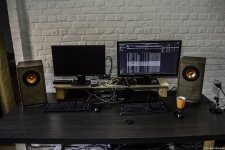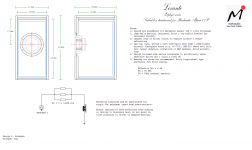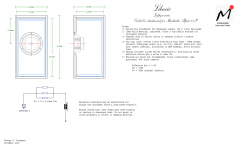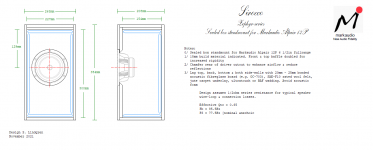Hi all.
I've recently assembled a pair of 7ms CGRs, and I'm quite happy with the result. I haven't had a chance to test them in a good room yet so can't give full evaluation for anyone curious. These are the only full range drivers I have heard, and I don't feel like I'm lacking anything over a two way in my current use case - apart from outright headroom.
I am curious to build a new standmount with either the 11ms, 10.3, or Pluvia 11. Possibly even the CHN110, but I understand that is designed for use in a bigger box.
I'd be happy to stick with the 7ms for my duties, however these will one day go into a WAW with some Alpair 12pw which are sitting in boxes, waiting for when I have space to have a large speaker.
The new speakers I make will most likely only be used nearfield. I am looking for something that can go a little lower than the 7ms, and also have more headroom - hence the size upgrade. I'd ideally be looking for extension into low 50s/high 40s - or low as possible realistically from a small box fullranger. In my room at the moment the 7ms are reaching low into the 50s.
From what I've read, I'm not sure if any of these drivers will reach lower in a small box, apart from possibly the 10.3. I'd appreciate some advice off of more knowledgable members.
I am most curious to hear the 11ms as that's the latest and greatest from MA, but I'm a bit concerned looking at the dip in the freq response, and then the peak in the treble. I'd be happy to just eq that down if it sounds okay but I'm worried it's distortion which can't really be fixed.
I'm curious to hear any thoughts from anyone who's heard the above drivers. Also, I know there's been some similar threads, but I wasn't able to see much information from them, I was wondering if there are any more opinions now.
Thanks
I've recently assembled a pair of 7ms CGRs, and I'm quite happy with the result. I haven't had a chance to test them in a good room yet so can't give full evaluation for anyone curious. These are the only full range drivers I have heard, and I don't feel like I'm lacking anything over a two way in my current use case - apart from outright headroom.
I am curious to build a new standmount with either the 11ms, 10.3, or Pluvia 11. Possibly even the CHN110, but I understand that is designed for use in a bigger box.
I'd be happy to stick with the 7ms for my duties, however these will one day go into a WAW with some Alpair 12pw which are sitting in boxes, waiting for when I have space to have a large speaker.
The new speakers I make will most likely only be used nearfield. I am looking for something that can go a little lower than the 7ms, and also have more headroom - hence the size upgrade. I'd ideally be looking for extension into low 50s/high 40s - or low as possible realistically from a small box fullranger. In my room at the moment the 7ms are reaching low into the 50s.
From what I've read, I'm not sure if any of these drivers will reach lower in a small box, apart from possibly the 10.3. I'd appreciate some advice off of more knowledgable members.
I am most curious to hear the 11ms as that's the latest and greatest from MA, but I'm a bit concerned looking at the dip in the freq response, and then the peak in the treble. I'd be happy to just eq that down if it sounds okay but I'm worried it's distortion which can't really be fixed.
I'm curious to hear any thoughts from anyone who's heard the above drivers. Also, I know there's been some similar threads, but I wasn't able to see much information from them, I was wondering if there are any more opinions now.
Thanks
I use the 10.3M in a 17.9L reflex tuned to 45Hz in my office with a little LCR filter and i'm very happy with those. I did not compare to the 11MS or the Pluvia11 altough.
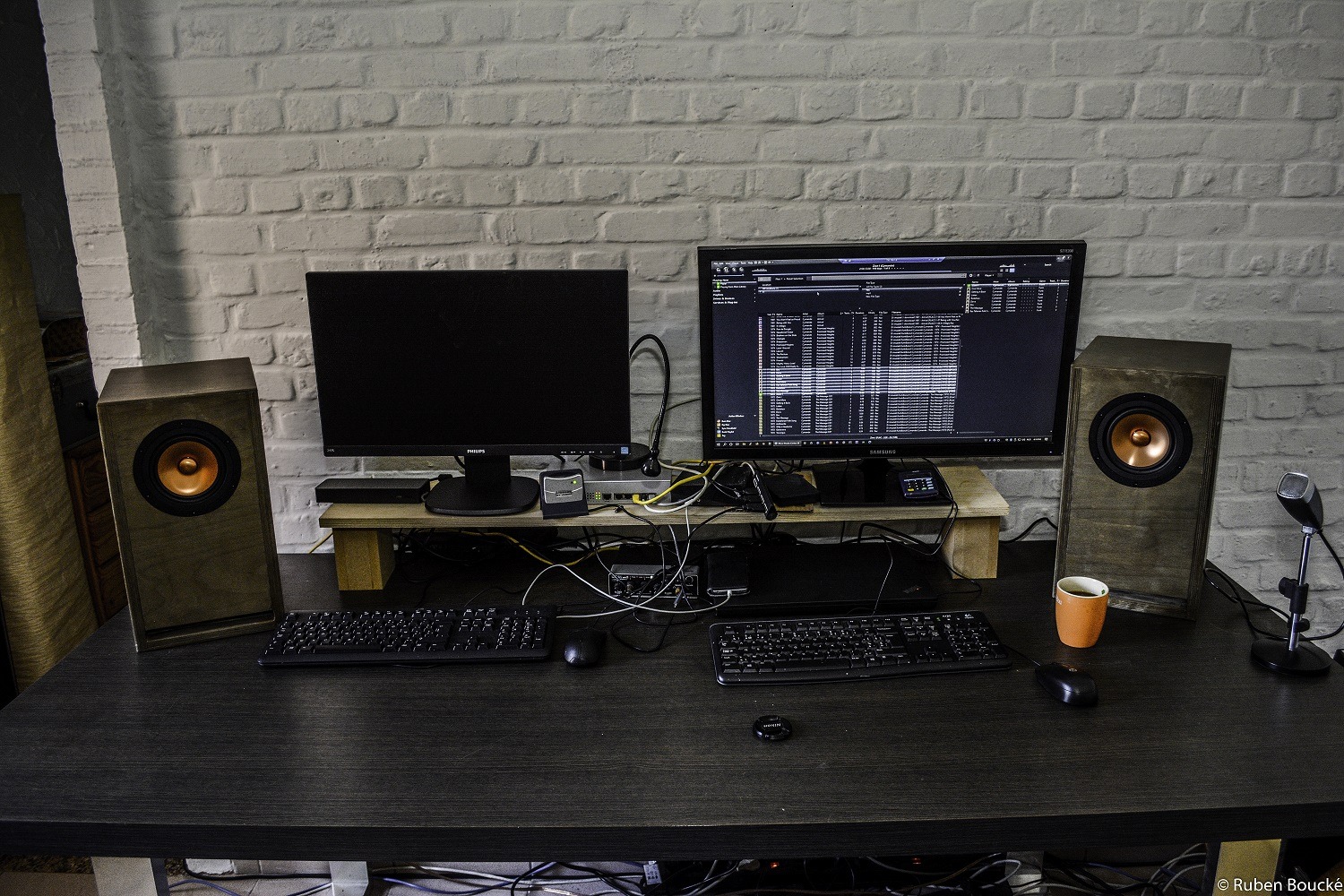
The CHN110 can go lower, but need a much bigger case (about double the volume) to do that. I use them in an standmount MLTL and there they are tuned to 33Hz. In a reflex 40Hz is doable (at least in sims).
The CHN110 can go lower, but need a much bigger case (about double the volume) to do that. I use them in an standmount MLTL and there they are tuned to 33Hz. In a reflex 40Hz is doable (at least in sims).
Attachments
Hi waxx, I thought I might hear from you as I've seen you mention the 10.3 around the forums.
How do you think it compares to the chn110? Is there much difference at all in overall sound quality, ignoring the extra bass.
I've never really understood the CH range as they seem to come in at different price points. With alpair and pluvia it's very straightforward to know which one sits higher in the range.
I'm curious to hear the 10.3 as it's been around for so long, meaning it must be a good driver. And the freq response just looks a lot easier on the eye than the 11ms
How do you think it compares to the chn110? Is there much difference at all in overall sound quality, ignoring the extra bass.
I've never really understood the CH range as they seem to come in at different price points. With alpair and pluvia it's very straightforward to know which one sits higher in the range.
I'm curious to hear the 10.3 as it's been around for so long, meaning it must be a good driver. And the freq response just looks a lot easier on the eye than the 11ms
CHN use a casted metal frame, Alpair uses a very hard stiff plastic frame that is much more rigid than the metal ones. The Alpair is a bit brighter and can work on smaller volumes but on sound it's more or less the same on quality. Both use the same kind of kopper alloy cones and suspension and magnet. Price don't reflect quality at Mark audio as some cheaper like the CHN110 are as good as the more expensive Alpair 10.3 series. Some say the alpair 10.3 have more detail but i doubt about it, and think people think about that because of the slightly brighter sound. If you like the Alpair 7MS, i think the alpair 10 or 11MS may be more your cup of tea as they got the same kind of sound (brighter topend) than the fairly neutral CHN110 or the darker sounding 10P. But brighter here means a little, not overly bright like many other FR drivers.
The difference between the 10.3 and the 11MS is mainly the suspension (dual suspension for the 10.3, mono suspension for the 11MS) and the frame (the 11MS is thinner but as stiff, the 10.3 is an older design with a bulky frame), and has as result that the 11MS does not go that low as the 10.3, but the difference is not that big. I prefer the 10.3, but some others (like Planet10) prefer the 11MS i thought. Both are great.
The difference between the 10.3 and the 11MS is mainly the suspension (dual suspension for the 10.3, mono suspension for the 11MS) and the frame (the 11MS is thinner but as stiff, the 10.3 is an older design with a bulky frame), and has as result that the 11MS does not go that low as the 10.3, but the difference is not that big. I prefer the 10.3, but some others (like Planet10) prefer the 11MS i thought. Both are great.
The P11 & A11ms will not really go lower then A7ms unless in one of the big boxes (ie FHXL/Pensil), A10.3 goes a bit lower. CHN-110 is really a standout (even excluding the low price), but does use enclosures similar in size to A12pw.
https://frugal-phile.com/boxlib/P10free/CGR-MK110-060121.pdf
dave
https://frugal-phile.com/boxlib/P10free/CGR-MK110-060121.pdf
dave
Yes, I'm aware of most the hardware differences. I forgot about the older thick frame of the 10.3 thoughCHN use a casted metal frame, Alpair uses a very hard stiff plastic frame that is much more rigid than the metal ones. The Alpair is a bit brighter and can work on smaller volumes but on sound it's more or less the same on quality. Both use the same kind of kopper alloy cones and suspension and magnet. Price don't reflect quality at Mark audio as some cheaper like the CHN110 are as good as the more expensive Alpair 10.3 series. Some say the alpair 10.3 have more detail but i doubt about it, and think people think about that because of the slightly brighter sound. If you like the Alpair 7MS, i think the alpair 10 or 11MS may be more your cup of tea as they got the same kind of sound (brighter topend) than the fairly neutral CHN110 or the darker sounding 10P. But brighter here means a little, not overly bright like many other FR drivers.
The difference between the 10.3 and the 11MS is mainly the suspension (dual suspension for the 10.3, mono suspension for the 11MS) and the frame (the 11MS is thinner but as stiff, the 10.3 is an older design with a bulky frame), and has as result that the 11MS does not go that low as the 10.3, but the difference is not that big. I prefer the 10.3, but some others (like Planet10) prefer the 11MS i thought. Both are great.
7ms is not very bright, from the freq response it has less top end than the 10.3. I've never listened to it and ever thought it was bright, but I am happy with the overall response. I wouldn't mind a bit more upper mids and treble though.
So you have heard the 11ms? What were your impressions at the time?
I'm just wondering what their upper trebles sound like and that giant dip around 400hz (from memory)
Yeah I thought not, that's my dilemma. How small can the A10.3 get realistically? I like that the 11ms can fit in a small enclosure. Ultimately I'd tradeoff a bit of bass extension for quality in the rest of the range and headroom (due to how the speakers will be used)The P11 & A11ms will not really go lower then A7ms unless in one of the big boxes (ie FHXL/Pensil), A10.3 goes a bit lower. CHN-110 is really a standout (even excluding the low price), but does use enclosures similar in size to A12pw.
https://frugal-phile.com/boxlib/P10free/CGR-MK110-060121.pdf
dave
Welll, i don't own the 11MS but did build a pencil for someone with it. It sounds very similar to the 10.3 and that dip is not really something that disturbs the sound i think. It's just a little less good than the 10.3 if i put them side by side. At that time i had the 10.3 in my old first cabinet still, wich was a not so good aligned ported cabinet from a plan from someone else without filter but i liked it more. Now it's in a own design ported with a LCR filter to tame the top resonance a bit that even sounds better.
I also had an other pair in a waw config (still first version) that also did sound better. I used and still use a 10" scanspeak woofer with it.
I also had an other pair in a waw config (still first version) that also did sound better. I used and still use a 10" scanspeak woofer with it.
If it gets too small it becomes tricy to mount the driver on the baffle.How small can the A10.3 get realistically?
No one has yet asled for something smaller than the optimal 13 litre miniOnken, but i suspect that it can be fitted into the same boxes as the A7/11ms/P11 thst is 9 litres. It might be possible to put it in an even smaller box, but at that point using thinner plywood will get you more gross volume reduction.
dave
And to add that, if you want bass from this driver, it need some volume.If it gets too small it becomes tricy to mount the driver on the baffle.
No one has yet asled for something smaller than the optimal 13 litre miniOnken, but i suspect that it can be fitted into the same boxes as the A7/11ms/P11 thst is 9 litres. It might be possible to put it in an even smaller box, but at that point using thinner plywood will get you more gross volume reduction.
dave
I think smaller than 13L is not really feasable, and to go into the mid 40's the 17.9 was a good size. That 13L limits it more to 50Hz i suppose and the 9L will put it even 10Hz higher with the Alpair 10.3. The 11MS can fit smaller boxes for the same frequency response i thought.
A 10.3 works fine in the 9 litre box. F10 in th elow 40s. It would probably fit into an even smaller box.
dave
dave
Interesting. Was there much difference or was it very small?Welll, i don't own the 11MS but did build a pencil for someone with it. It sounds very similar to the 10.3 and that dip is not really something that disturbs the sound i think. It's just a little less good than the 10.3 if i put them side by side. At that time i had the 10.3 in my old first cabinet still, wich was a not so good aligned ported cabinet from a plan from someone else without filter but i liked it more. Now it's in a own design ported with a LCR filter to tame the top resonance a bit that even sounds better.
I also had an other pair in a waw config (still first version) that also did sound better. I used and still use a 10" scanspeak woofer with it.
I'm wondering which sounded more 3d to you, I take it you don't remember very well now?
Something like 13l is small enough. I could probably go bigger too.If it gets too small it becomes tricy to mount the driver on the baffle.
No one has yet asled for something smaller than the optimal 13 litre miniOnken, but i suspect that it can be fitted into the same boxes as the A7/11ms/P11 thst is 9 litres. It might be possible to put it in an even smaller box, but at that point using thinner plywood will get you more gross volume reduction.
dave
Dave, I'm wondering if you've had a chance to hear the stock 10.3 vs the 11ms, if so could you also provide any insight?
I've noticed the SD on the 11ms is nearly 30% greater (111cm vs 88cm) so I wonder how that translates into output. The 7ms are okay 90% of the time, but can quickly run out of headroom (even nearfield) and they're about 50cm I think, any extra SD is appreciated. I prefer the driver to be moving as little as possible as I believe more movement will add more distortion. I do also have an eq cutting bass down drastically under 50hz
Something like 13l is small enough. I could probably go bigger too.
The A10.3 doesn’t work in the miniOnken alignment in a box larger than 13litre.
Not a stock a10.3. We compared A10.3eN in Pensil to stock A11ms in Seastack. Over all people preferred the A11ms, except that teh EnABLed driver was definitly better at 3D image/soundstage.I'm wondering if you've had a chance to hear the stock 10.3 vs the 11ms, if so could you also provide any insight?
Chris took both home for a while and decided to keep A10.3eN.
dave
The A10.3 doesn’t work in the miniOnken alignment in a box larger than 13litre.
Not a stock a10.3. We compared A10.3eN in Pensil to stock A11ms in Seastack. Over all people preferred the A11ms, except that teh EnABLed driver was definitly better at 3D image/soundstage.
Chris took both home for a while and decided to keep A10.3eN.
dave
That's interesting. I thought the single suspension would help in soundstage. I'm wondering how much benefit single suspension really brings.
I'm mostly leaning towards the 11ms as they're newer, but something tells me the 10.3 are a proven and solid performer, which is why I'm finding it hard to decide.
They're actually the same price on kjf now as well
I'm wondering how much benefit single suspension really brings.
It does. It has been speculated that one might not have as much control at the bottom, but this has not really been shown to be an issue.
The difference between the A10.3eN and the A10.3 stock is very much about their ability to reproduce little stuff. I have not yet EnABLed A11ms but i fully expect that would raise that one capability above the EnABLed A10.3
dave
I was wondering about how the bass compares.
So it looks like it's about 1-1 for the 11ms and 10.3 so far. I imagine the 10.3 must have some pros over the 11ms if they're still around
Would be curious to hear from more 11ms owners, I don't think I've ever read anything bad about them to be fair
So it looks like it's about 1-1 for the 11ms and 10.3 so far. I imagine the 10.3 must have some pros over the 11ms if they're still around
Would be curious to hear from more 11ms owners, I don't think I've ever read anything bad about them to be fair
Thanks for chiming in, Scott.As I understand it, the 10.3 is quite simply still built because people continue to buy them.
I was looking at your Nostromo plans, and I am guessing I would have to use the biggest box version. I don't have a SET amp, I'll probably be using 3E audio TPA3255 amp, or a class AB amp of some kind.
Do you mind giving a really quick explanation on why the sizes vary and how this will affect the overall sound and how it interacts with the amp?
Assuming the output impedance of your amplifier is low, then the smaller cabinets would be preferable. You can look at it a couple of ways; probably the easiest is to view it from the perspective of electrical damping. The higher the amplifier's output impedance, the lower the amount of electrical damping it provides -in effect, it's like artificially raising the driver's Qes, and thereby the effective Qts (Qts'). Since Vas and Fs remain unchanged (Q, Vas and Fs dominating in terms of LF alignment), as the effective Qt rises, so does the required box volume.
This might help a little: I posted them on a different thread a few weeks back. Three boxes for the Alpair 12P. They all have the same (more or less) Qtc alignment, if fed with a voltage source / low output impedance amplifier, such as a typical solid state class AB, class D etc.
Starting with the smallest (they're not in order), that's 'as is', with the driver alone, assuming a minor adjustment for typical wire-loop & connection resistance. Moving up, you'll see I've added some series resistance to artificially raise the driver Qts, allowing a larger box and a lower Fb while still achieving the same system Qtc. The greater the amount of series R, the higher the driver's effective Qts becomes, so the larger the box needs to be, and the lower its tuning for a given Qtc alignment. The downside is reduced sensitivity and power-handling, plus the resistors get rather hot; no free lunches in physics. 😉 My preferred implementation of resistors in this case would actually be to use them externally, with a grid of about 15 - 20 small metal films, probably 2w rated or similar. Better heat-dissipation, theoretically easier to trim out, and the multiples ensure you're never near their power-handling limits. Probably a bit OTT for many though...
Starting with the smallest (they're not in order), that's 'as is', with the driver alone, assuming a minor adjustment for typical wire-loop & connection resistance. Moving up, you'll see I've added some series resistance to artificially raise the driver Qts, allowing a larger box and a lower Fb while still achieving the same system Qtc. The greater the amount of series R, the higher the driver's effective Qts becomes, so the larger the box needs to be, and the lower its tuning for a given Qtc alignment. The downside is reduced sensitivity and power-handling, plus the resistors get rather hot; no free lunches in physics. 😉 My preferred implementation of resistors in this case would actually be to use them externally, with a grid of about 15 - 20 small metal films, probably 2w rated or similar. Better heat-dissipation, theoretically easier to trim out, and the multiples ensure you're never near their power-handling limits. Probably a bit OTT for many though...
Attachments
I see, thanks for that detailed write up.
I honestly didn't realise that the AB and class D amps are in the low output impedance category. I take it I would need the smallest nostromo then?
I'm surprised I've never seen much mentioned about pairing amplifiers and their output impedance to specific speaker boxes
I honestly didn't realise that the AB and class D amps are in the low output impedance category. I take it I would need the smallest nostromo then?
I'm surprised I've never seen much mentioned about pairing amplifiers and their output impedance to specific speaker boxes
- Home
- Loudspeakers
- Full Range
- Alpair 11ms, 10.3, Pluvia 11, or other?
